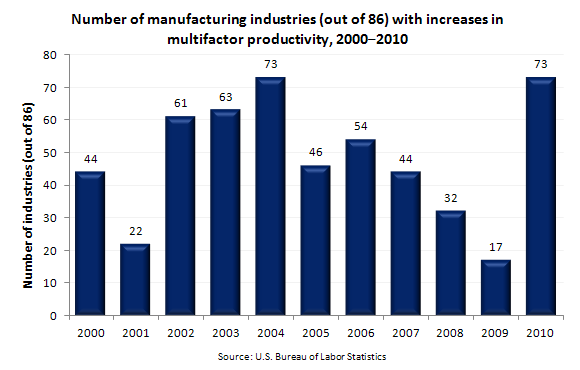October 1, 2012 (The Editor’s Desk is updated each business day.)
Multifactor productivity trends in 2010
Multifactor productivity—defined as output per unit of combined inputs—increased in 73 of 86 manufacturing industries in 2010, up from 2009 when multifactor productivity increased in only 17 of those industries. More industries recorded multifactor productivity gains in 2010 than in any year since 2004.

[Chart data]
Seventeen manufacturing industries recorded double-digit percent increases in multifactor productivity in 2010. Industries where multifactor productivity rose most were semiconductors and electronic components (28.9 percent), motor vehicles (18.7 percent), leather and hide tanning and finishing (17.6 percent), forging and stamping (14.8 percent), and cutlery and hand tools (14.2 percent).
Multifactor productivity rose in both of the transportation industries studied in 2010: 3.8 percent in air transportation (more than in any of the previous 4 years) and 7.3 percent in line-haul railroads (more than in any other year since 1987).
These data are from the Multifactor Productivity program. To learn more, see “Multifactor Productivity Trends for Detailed Industries, 2010” (HTML) (PDF), news release USDL-12-1938. Multifactor productivity growth measures the extent to which output growth has exceeded the growth in inputs, and reflects the joint influences on economic growth of a variety of factors, including technological change, returns to scale, enhancements in managerial and staff skills, changes in the organization of production, and other efficiency improvements.
Related TED articles
Industry Studies |
Manufacturing |Productivity
Of interest
Spotlight on Statistics: National Hispanic Heritage Month
In this Spotlight, we take a look at the Hispanic labor force—including labor force participation, employment and unemployment, educational attainment, geographic location, country of birth, earnings, consumer expenditures, time use, workplace injuries, and employment projections.
Read more »
